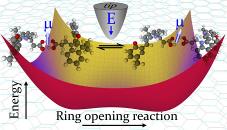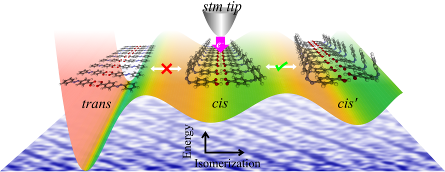

|
Growth polymorphs of ferrocene derivatives at solid-air interface is controlled by the selection of the solvent from which the molecules are assembling on surface. Thermodynamically driven patterns of molecules can be assisted by establishing an equilibrium at the interface. When molecules are deposited from solvents with high boiling point or high solubility of molecules in solvents we observed formation of thermodynamically favorable pattern. More.. |


|
Adlayers of trimesic acid (TMA) and benzene-tricarboxaldehyde (TCA) on highly oriented pyrolytic graphite (HOPG) at solid-air interface are shown in the image. The strong and weak hydrogen bonding in TMA and TCA, respectively, control the assembly. More.. |
|
Molecular Functional Materials Research Group |
|
© T. G. Gopakumar, IITK |
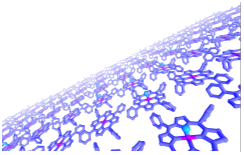
|
Research |
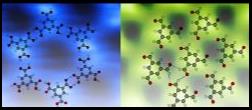


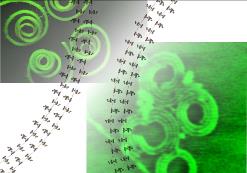
|
Discrete spherical/porous structures of macro/large biomolecules are commonly observed in nature, which are stabilized by the interplay of enormous inter and intramolecular interactions within them. However, such structures are not very commonly observed when small molecules assemble on surfaces. We showed a molecular rings/spiral of rather small molecules (ferrocene) on surface. The rings/spirals can be used to understand the Limits of Intermolecular Interactions. Link.. |

|
On-surface reaction of an aromatic aldehyde and aromatic amine leads to the formation of a 2D imine covalent organic framework (2D COF). The band-structure and the electron density on the network reveals possible application in electronic thin films devices. Link.. |

|
Two-dimensional covalent organic frameworks (2D-COFs) belong to a new class of molecular materials that have attracted huge attention in recent years due to their analogous nature to graphene. Band gap and electronic structure of 2D-COF can be tuned by selection of suitable precursors molecules forming COF. We show that nitrogen atom doping in 2D-COF is very effective in tuning the band gap. Link.. |

|
Two dimensional surface confined metal organic network (SMON) are metal doped self assembled monolayer of molecules on solid surfaces. We show the formation of uniform large area solution processed semi-conducting SMONs of Pd and Zn with mellitic acid (MA) on highly oriented pyrolytic graphite (HOPG) surface at ambient conditions. Using tunneling spectroscopy we observed a reduction in the band gap of 900 meV and 300 meV for MA-Pd and MA-Zn SMON, respectively, compared to pure MA assembly. Link.. |
|
Molecule that posses different geometrical, which are electronically distinguishable, can act as molecular switches. These states may be controlled by electrons, electrical field and light. We report the reversible electron- and light-induced switching of carboxyl functionalized azo-benzene molecules at HOPG/air interface using STM. The switching is mediated through a stable charged electronic state of the molecules and is offering low threshold voltage for the switching. The strong intermolecular interaction plays a vital role is stabilizing different states of the molecules on surface while switching. Link.. |
|
The trans isomer of azobenzene (AB) and its derivatives is the most abundant isomer at thermodynamic equilibrium and is known to switch between its trans and cis isomers when triggered by light, electrons/holes and electrical field in adlayers on surfaces. However, the equilibrium initial condition limits the operation of molecular switches on surface due to large activation barrier for switching (trans to cis), hence the switching probability is very low. We can condense the non-equilibrium cis state of azobenzene derivatives on graphite. When electrons/holes induced switching is performed on these molecular switches from the meta-stable initial condition, the switching probability is enhanced by several folds. Link.. |
|
A new class of pyridine-based spiropyran (SP), which shows photo-induced reversible switching between the closed SP and ring-opened merocyanine (MC). We show that a condensed crystalline monolayer of SP on graphite can be quantitatively converted to MC upon UV irradiation. In solution only about 10% of SP can be transformed to MC due to the establishment of a photo-stationary state. Using an electrical field applied by a scanning tunneling microscope (STM) tip, single molecules are reversibly switched between SP and MC forms in their condensed phases without any threshold voltage at ambient conditions. Link.. |
|
Understanding the formation and disassembly of molecular adlayer patterns on surfaces at the molecular level has high fundamental and applied importance. With the combination of atomic force micrographs and statistical analysis of adlayers annealed to different temperatures of two similar molecules (trimesic acid and benzene-1,3,5-tricarboxaldehyde), the enthalpy to disassembly (DdisH) molecules from a molecular pattern on surface is quantitatively determined. The difference in the inter-molecular interaction in their molecular patterns could be directly quantified from DdisH. We also observed that DdisH decreases with decreasing initial absolute coverage of adlayer, which turns out to be related to the measure of the average number of inter-molecular interactions per molecule in a given adlayer pattern. By determining the change in entropy and Gibb’s free energy, we could predict precisely the threshold temperature for the disassembly of the molecular patterns. Link.. |

